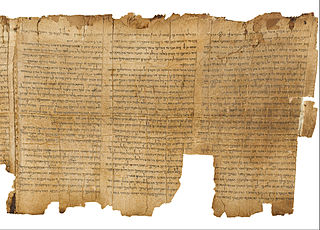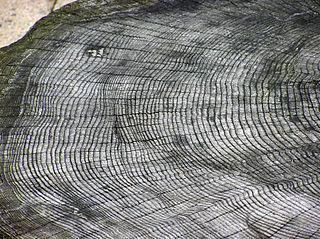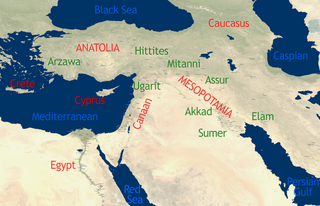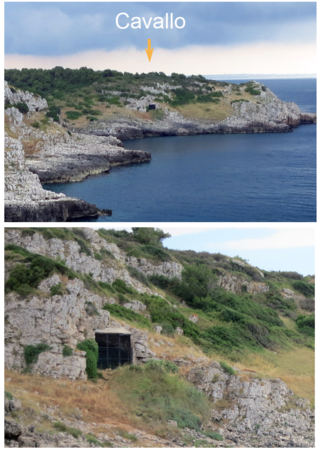Related Research Articles

Radiocarbon dating is a method for determining the age of an object containing organic material by using the properties of radiocarbon, a radioactive isotope of carbon.

Dendrochronology is the scientific method of dating tree rings to the exact year they were formed in a tree. As well as dating them, this can give data for dendroclimatology, the study of climate and atmospheric conditions during different periods in history from the wood of old trees. Dendrochronology derives from the Ancient Greek dendron, meaning "tree", khronos, meaning "time", and -logia, "the study of".
The Research Laboratory for Archaeology and the History of Art (RLAHA) is a laboratory at the University of Oxford, England which develops and applies scientific methods to the study of the past. It was established in 1955 and its first director was Teddy Hall. The first deputy director was Dr Stuart Young, who was followed by Martin Aitken in 1957. After many years of de facto association with the Institute of Archaeology, in 2000 it was jointly brought under the single departmental umbrella of School of Archaeology.
The Châtelperronian is a proposed industry of the Upper Palaeolithic, the existence of which is debated. It represents both the only Upper Palaeolithic industry made by Neanderthals and the earliest Upper Palaeolithic industry in central and southwestern France, as well as in northern Spain. It derives its name from Châtelperron, the French village closest to the type site, the cave La Grotte des Fées.
Before Present (BP) or "years before present (YBP)" is a time scale used mainly in archaeology, geology, and other scientific disciplines to specify when events occurred relative to the origin of practical radiocarbon dating in the 1950s. Because the "present" time changes, standard practice is to use 1 January 1950 as the commencement date (epoch) of the age scale, with 1950 being labelled as the "standard year". The abbreviation "BP" has been interpreted retrospectively as "Before Physics", which refers to the time before nuclear weapons testing artificially altered the proportion of the carbon isotopes in the atmosphere, which scientists must account for.

Accelerator mass spectrometry (AMS) is a form of mass spectrometry that accelerates ions to extraordinarily high kinetic energies before mass analysis. The special strength of AMS among the different methods of mass spectrometry is its ability to separate a rare isotope from an abundant neighboring mass. The method suppresses molecular isobars completely and in many cases can also separate atomic isobars. This makes possible the detection of naturally occurring, long-lived radio-isotopes such as 10Be, 36Cl, 26Al and 14C.

The majority of Egyptologists agree on the outline and many details of the chronology of Ancient Egypt. This scholarly consensus is known as the Conventional Egyptian chronology, which places the beginning of the Old Kingdom in the 27th century BC, the beginning of the Middle Kingdom in the 21st century BC and the beginning of the New Kingdom in the mid-16th century BC.

The Minoan eruption was a catastrophic volcanic eruption that devastated the Aegean island of Thera circa 1600 BCE. It destroyed the Minoan settlement at Akrotiri, as well as communities and agricultural areas on nearby islands and the coast of Crete with subsequent earthquakes and paleotsunamis. With a Volcanic Explosivity Index (VEI) of 6, it resulted in the ejection of approximately 28–41 km3 (6.7–9.8 cu mi) of dense-rock equivalent (DRE), the eruption was one of the largest volcanic events in human history. Since tephra from the Minoan eruption serves as a marker horizon in nearly all archaeological sites in the Eastern Mediterranean, its precise date is of high importance and has been fiercely debated among archaeologists and volcanologists for decades, without coming to a definite conclusion.

A destruction layer is a stratum found in the excavation of an archaeological site showing evidence of the hiding and burial of valuables, the presence of widespread fire, mass murder, unburied corpses, loose weapons in public places, or other evidence of destruction, either by natural causes, or as a result of a human action.

The Grotte du Renne is one of the many caves at Arcy-sur-Cure in France, an archaeological site of the Middle/Upper Paleolithic period in the Yonne departement, Bourgogne-Franche-Comté. It contains Châtelperronian lithic industry and Neanderthal remains. Grotte du Renne has been argued to provide the best evidence that Neanderthals developed aspects of modern behaviour before contact with modern humans, but this has been challenged by radiological dates, which suggest mixing of later human artifacts with Neanderthal remains. However, it has also been argued that the radiometric dates have been affected by post-recovery contamination, and statistical testing suggests the association between Neanderthal remains, Châtelperronian artefacts and personal ornaments is genuine, not the result of post-depositional processes.
During regular archaeological excavations, several flutes that date to the European Upper Paleolithic were discovered in caves in the Swabian Alb region of Germany. Dated and tested independently by two laboratories, in England and Germany, the artifacts are authentic products of the Aurignacian archaeological culture. The Aurignacian flutes were created between 43,000 and 35,000 years ago. The flutes, made of bone and ivory, represent the earliest known musical instruments and provide unmistakable evidence of prehistoric music.

The chronology of the ancient Near East is a framework of dates for various events, rulers and dynasties. Historical inscriptions and texts customarily record events in terms of a succession of officials or rulers: "in the year X of king Y". Comparing many records pieces together a relative chronology relating dates in cities over a wide area.
The ASPRO chronology is a nine-period dating system of the ancient Near East used by the Maison de l'Orient et de la Méditerranée for archaeological sites aged between 14,000 and 5,700 BP.

Lake Suigetsu is a lake in the Hokuriku region of Honshu, Japan, which is one of the Mikata Five Lakes located in Mihama and Wakasa, Fukui Prefecture, close to the coast of the Wakasa Bay in the Sea of Japan. Since 1993, it has been attracting the attention of scientists because of the undisturbed nature of the water for many thousands of years. It is possible to identify the annual deposits of silt in a similar manner that tree rings are identified.
Radiocarbon dating measurements produce ages in "radiocarbon years", which must be converted to calendar ages by a process called calibration. Calibration is needed because the atmospheric 14
C:12
C ratio, which is a key element in calculating radiocarbon ages, has not been constant historically.

The Grotta del Cavallo or Cavallo Cave is a limestone cave in the region of Apulia, Southern Italy, near Nardò 90 km (55.92 mi) south of Taranto. The cave is about 15 m (49 ft) above present sea level. It has a rounded entrance, 5 m (16.40 ft) wide and 2.5 m (8.20 ft) high opening toward the sea. The cave was rediscovered in 1960 and two waves of excavations ensued. The first wave spanning from 1963 to 1966 and the second from 1986 to 2008. The cave was disturbed by looters during the period between the two waves of excavations, damaging the layers corresponding to the Upper Palaeolithic; because of this, the cave entrance is covered by a gate and is closed to the public.
Thomas F. G. Higham is an archaeological scientist and radiocarbon dating specialist. He has worked as Professor of Archaeological Science at the University of Oxford, UK, where he was the Director of the Oxford Radiocarbon Accelerator Unit (ORAU) in the Research Lab for Archaeology and the History of Art. He is best known for his work in dating the Neanderthal extinction and the arrival of modern humans in Europe. He is Professor in the Department of Evolutionary Anthropology at the University of Vienna.
Roger Michael Jacobi was a British archaeologist specialising in Palaeolithic and Mesolithic Britain. Known for his encyclopaedic knowledge of British prehistory, Jacobi authored several key synthetic volumes and worked to catalogue, sequence and reanalyse collections from across Britain and northwestern Europe. Sections of his extensive personal archive were posthumously published as the Palaeolithic and Mesolithic Artefact (PaMELA) database. He studied archaeology at Jesus College, Cambridge, and held positions at Lancaster University, the University of Nottingham, and the British Museum.

Archaeometry is a peer-reviewed academic journal covering archaeological science, particularly absolute dating methods, artefact studies, quantitative archaeology, remote sensing, conservation science, and environmental archaeology. It is published bimonthly by Wiley-Blackwell, on behalf of the Research Laboratory for Archaeology and the History of Art at the University of Oxford, in association with the Gesellschaft für Naturwissenschaftliche Archäologie Archäometrie and the Society for Archaeological Sciences. Its current editors are A. Mark Pollard, Ina Reiche, Brandi MacDonald, Gilberto Artioli, and Catherine Batt.

Paula Jo Reimer is a radiocarbon and archaeological scientist. Reimer is the former director of the 14Chrono Centre for Climate, the Environment, and Chronology at Queen's University Belfast.
References
- 1 2 3 4 5 "Professor Christopher Bronk Ramsey". University of Oxford. Retrieved 2023-03-27.
- ↑ "Emeritus, Visiting and Honorary Fellows at Merton College, Oxford". Merton College, Oxford. Archived from the original on 2013-06-18. Retrieved 2012-09-26.
- ↑ "Prof Christopher Ramsey". Merton College, Oxford. Archived from the original on 2012-10-23. Retrieved 2012-09-26.
- ↑ "Accelerator mass spectrometry for radiocarbon dating: Advances in theory and practice". The British Library. Retrieved 2012-09-26.
- ↑ Telford RJ, Heegaard E, Birks HJ (2004), "The Intercept is a Poor Estimate of a Calibrated Radiocarbon Age", Holocene, 14 (2): 296–298, Bibcode:2004Holoc..14..296T, doi:10.1191/0959683604hl707fa, hdl: 1956/414 , S2CID 55349569
- ↑ Adam Michczynski; Anna Pazdur (2003). "The Method of Combining Radiocarbon Dates and Other Information in Application to Study the Chronologies of Archaeological Sites" (PDF). Geochronometria - Journal on Methods and Applications of Absolute Chronology. 22: 41. Retrieved 2012-09-26.
- ↑ Manning SW, Ramsey CB, Kutschera W, Higham T, Kromer B, Steier P, et al. (2006). "Chronology for the Aegean Late Bronze Age 1700-1400 B.C.". Science. 312 (5773): 565–9. Bibcode:2006Sci...312..565M. doi:10.1126/science.1125682. PMID 16645092. S2CID 21557268.
- ↑ Bayliss, Alex; Bronk Ramsey, Christopher; van der Plicht, Johannes; Whittle, Alasdair (2007). "Bradshaw and Bayes: Towards a Timetable for the Neolithic". Cambridge Archaeological Journal. 17 (S1): 1. doi:10.1017/S0959774307000145. ISSN 0959-7743. S2CID 162329707.
- ↑ Gravina B, Mellars P, Bronk Ramsey C (2005). "Radiocarbon Dating of Interstratified Neanderthal and Early Modern Human Occupations at the Chatelperronian Type-site". Nature. 438 (7064): 51–56. Bibcode:2005Natur.438...51G. doi:10.1038/nature04006. PMID 16136079. S2CID 4335868.
- ↑ Bhanoo, Sindya N. (21 June 2010). "Pharaohs Are Given an Update". The New York Times. Retrieved 2012-09-26.
- ↑ "QSR: Most cited Articles".
- ↑ "New Scientist: Lake Bed".
- ↑ "Staff Spotlight: Professor Christopher Bronk Ramsey". University of Oxford. Retrieved 21 April 2024.